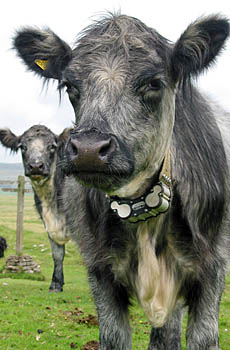 If you caught the Pennine episode of Griff Rhys Jones’s Mountain odyssey, you may remember the furry-eared cows being introduced to the karst landscape of the Yorkshire Dales limestone pavements in an attempt to preserve the delicate fauna of the area which sheep destroy with their ravenous feeding regimes.
If you caught the Pennine episode of Griff Rhys Jones’s Mountain odyssey, you may remember the furry-eared cows being introduced to the karst landscape of the Yorkshire Dales limestone pavements in an attempt to preserve the delicate fauna of the area which sheep destroy with their ravenous feeding regimes.
Well, the little cows have gone high tech and can now boast GPS sat-nav as they wander around the clints and grykes of the Dales.
One of the cows wearing a GPS collar
The herd of 50 Blue Grey and beef Shorthorn cattle now wears collars which use the Global Positioning System devices to record where they are, whether they are on the move and even whether they are grazing or not – talk about Big Brother!
An original five-year plan to reintroduce mixed livestock where previously only sheep grazed has been successful and has been given a year-long extension.
The hope is that farmers in the area will be persuaded to return to using hardy cattle breeds. Data collected by the GPS collars will be used to analyse how the cows behave on the Ingleborough Nature Reserve, in the shadow of one of Yorkshire’s Three Peaks.
Paul Evans, the reserve’s manager, said: “The idea is to find out where they go and at what times of the day and the year. We can then analyse the vegetation and terrain in those areas – for example grassland, peat bog or scrub.
“That will tell us what they prefer to eat during the different seasons of the year and this will help us to asses their impact on the local ecology.
“This detailed information on animal behaviour will help us develop management techniques to direct the cattle away from certain areas and into others.
“I think this is one of the first projects of its kind to use GPS collars on livestock – normally they are put on wild animals like polar bears and tigers to track their movements.”
It is hoped the scheme can then be extended to other parts of the Yorkshire Dales. Natural England, which runs the reserve, is working with the Yorkshire Dales National Park Authority and the National Trust with support from the EU-LIFE nature fund.
Heatherhopper
05 September 2007Clints and grykes!